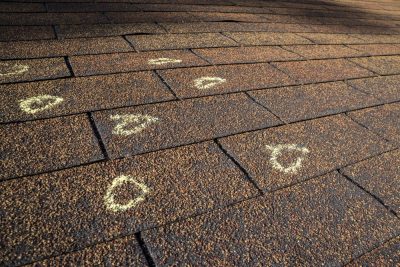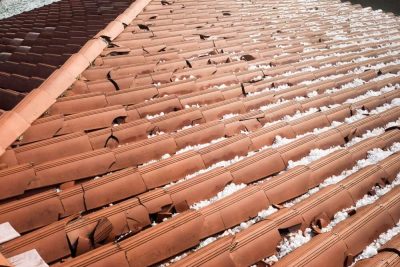-
By Admin

Talk to an Expert (504) 688-3387

Talk to an Expert (504) 688-3387
Be on the lookout for granule loss on asphalt shingles, bruising and splits on wood shingles, etc. Metal roofs can have small dimples, and flat roofs can be punctured or have pooled water. If you can catch damage early with support from Big Easy Roof Repairs, it will protect you from unexpected leaks and costly repairs.
Don’t wait until small issues turn into bigger problems—contact us today for a thorough roof inspection and let our team help keep your home safe and secure.

Hail damage on a roof could be anything from pure cosmetic damage to a structural damage issue. Understanding the signs early could prevent more damage and get your roof to last longer.
Bruising is when hailstones produce soft spots or indentations on shingles. Then sweep your fingers across the shingle surface to detect these spots. Missing granules often come hand in hand with bruising, exposing the asphalt layer.
Granule loss is an indication of hail damage. Check for bald spots on shingles with granules that have been ripped off. Granules tend to accumulate in gutters and downspouts, so inspect these locations as well for buildup.
Inspect for shingle cracks and fractures from larger hailstones. These can permit water to seep and cause leaks and structural damage. Check shingle edges for splits or tears, since hail impact tends to compromise this part of the shingle.
Severe hail damage can tear open the underlayment or felt that is underneath the shingles. Rip, tear, or puncture the felt or underlayment, and seeing those holes can let moisture in underneath the decking.
Roof vents and metal flashing are especially susceptible to hail. Look for obvious dents or dings, and slushy splatter marks of hailstones wiping away dirt.
Property inspection following a hailstorm is imperative to determine possible damage and prevent expensive repairs by evaluating your property within 24-48 hours. Hail doesn’t just ruin your roof — it can take out your siding, windows, gutters, and decks. Below are the key areas to inspect:
Check your gutters for dents or ‘dings’ from hail. These are typically located on the edges or downspouts. Shingle granules can collect in them after a storm, an indicator of likely roof damage.
Hail may dent, crack, or chip siding materials such as vinyl or wood. Painted surfaces might exhibit peeling or chipping from the blow. Look closely for stab holes or tears.
Check for cracked or broken window glass. Frames, too, can get dents or chipping from hail. Window screens are especially susceptible, so look for tears or holes. Finally, check windows – even if they’re not stuck open, damage to their mechanism or alignment might make them not close properly.
Inspect decks for dents, scratches, or splintered wood. You might see impact marks with painted or stained surfaces. Look for structural damage, like loose boards or cracks in support beams that would affect safety and stability.

Hail damage doesn’t end at your roof. While you may see dents or granules missing, the real damage may be below the surface, hidden from view. If these problems are not dealt with, they can escalate and cause expensive repairs or even lead to structural failure.
Water intrusion is the hidden damage lurking below hail damage, first seen in the attic. Water stains or patches in ceilings or walls need to be investigated for a leak. Water that drips, no matter how small, or puddles on the floor in your attic, is calling to be addressed at once.
Hail can do hidden damage to insulation. Begin by seeking out soaked or waterborne sections of the paper. Wet insulation becomes ineffective and causes your energy bills to increase as heating and cooling become inefficient. Look for sagging or clumping, obvious indicators that water has invaded the insulation’s protective barrier.
Hail can damage roofs by harming the structural pieces of your roof. The wood beams and rafters can crack or warp from being wet for too long. Metal, such as fasteners or brackets, can rust or corrode. Roof decking, below the surface, can give way.
Hail damage can hide and create more problems than what appears on the surface. Investing several minutes in inspecting your roof and yard following a storm can protect your home from further problems.
Look for signs of damage such as cracks, dents, or missing shingles. Also, keep an eye on your gutters, siding, and the ground. Minor damage can develop into leaks or structural problems down the road.
If something appears wrong, having a pro come take a closer look is logical. Our experienced roofers at Big Easy Roof Repairs can identify concealed damage and suggest repairs before it’s too late. Call us today! Safeguarding your roof safeguards your home, period.